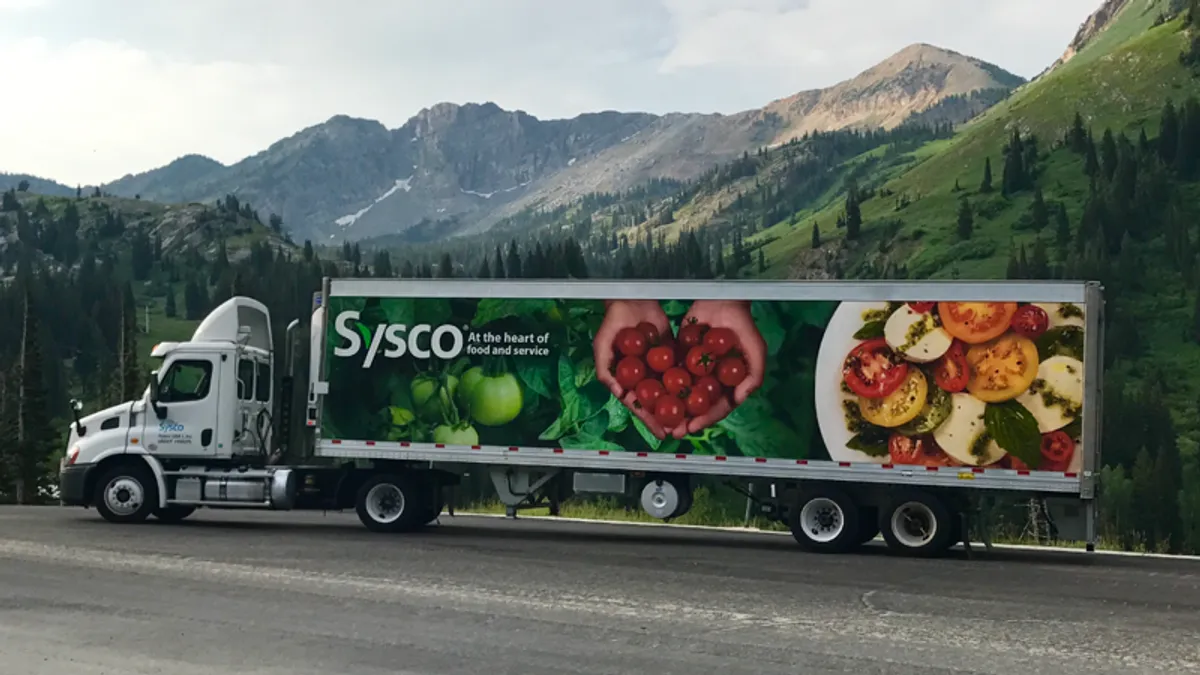Dive Brief:
- Sysco will work to lower scope 3 emissions throughout its supply chain by partnering with its highest-emitting suppliers to establish sustainability targets in line with the goals of the Paris Agreement by 2026, according to the company's 2021 Corporate Social Responsibility report.
- Scope 3 emissions are Sysco's "largest opportunity for impact" as they make up 98% of its total carbon footprint, according to the report. The majority of the company's emissions stem from food production and transportation between growers, suppliers and customers.
- The company is also taking steps to reduce its direct emissions, in part by electrifying 35% of its U.S. tractor fleet by 2030. Sysco has already conducted tests of the zero-emission Freightliner eCascadia at its Bay Area operating site and will deploy its first group of EVs in Riverside, California in fiscal year 2023.
Food production largest driver of Sysco's indirect emissions
Dive Insight:
Scope 3 emissions, which are tied to what companies purchase throughout their supply chain tiers, account for more than 90% of total emissions for an average packaged food company, according to Rabobank. This disproportionate share has more companies within the food industry engaging with suppliers to reduce their carbon footprints.
Among the examples: Mars, PepsiCo and McCormick are part of a climate coalition that will provide suppliers with resources and tools to form emissions-reduction plans. Starbucks has set goals focused on farm practices and land usage to improve sustainability in its coffee sourcing. And Chr. Hansen is engaging with its suppliers to reduce 20% of scope 3 greenhouse gases by 2030.
For Sysco, 90% of its scope 3 emissions comes from purchased goods and services, such as raw materials, packaging and food production. This is in line with emissions generated by the food sector overall, the company said.
Sysco is already making progress on the supplier side of its sustainability puzzle. At least 80 of its suppliers representing nearly 30% of its 2019 emissions have committed or set science-based targets, according to the company's report. Targets deemed as science-based are in line with what the latest science says is necessary to meet the Paris Agreement's aim to limit global warming to 1.5 degrees Celsius above pre-industrial levels.
"Our engagement will focus first on suppliers with the largest emissions contribution and then will shift toward smaller suppliers," Sysco said. "Since our supplier base is large and varied, each supplier requires a different level of engagement and support."
Within its own operations, Sysco is prioritizing the electrification of its U.S. tractor fleet, which is expected to reduce its emissions and maintenance costs. According to the company's report, the recent pilot of the Freightliner eCascadia was a success, as its drivers "enjoyed the EV's powerful, yet smooth and quiet ride."
Sysco said it will continue the Freightliner collaboration to make sure new EVs meet the unique transportation requirements for food distribution. It added that the industry lacks options for electric trailers with multi-temperature storage systems and long-distance electric tractor fleets that can meet its food safety and quality standards.
The company is rolling out efforts beyond fleet electrification to reduce its transportation emissions.
Sysco launched load-fill optimization capabilities to many of its regional distribution center lanes and some operating sites, which reduced the number of trucks used to stock its sites. In 2021, Sysco avoided 82 truckloads due to improved load-fill.
Sysco also leaned on intermodal and rail shipping, which provided it with "significant environmental and cost advantages," per the report. However, Sysco pared back its use of rail toward the end of the year and shifted to transportation modes with shorter lead times to maintain service levels.















